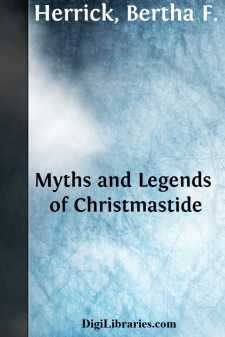Categories
- Antiques & Collectibles 13
- Architecture 36
- Art 48
- Bibles 22
- Biography & Autobiography 813
- Body, Mind & Spirit 142
- Business & Economics 28
- Children's Books 17
- Children's Fiction 14
- Computers 4
- Cooking 94
- Crafts & Hobbies 4
- Drama 346
- Education 46
- Family & Relationships 57
- Fiction 11829
- Games 19
- Gardening 17
- Health & Fitness 34
- History 1377
- House & Home 1
- Humor 147
- Juvenile Fiction 1873
- Juvenile Nonfiction 202
- Language Arts & Disciplines 88
- Law 16
- Literary Collections 686
- Literary Criticism 179
- Mathematics 13
- Medical 41
- Music 40
- Nature 179
- Non-Classifiable 1768
- Performing Arts 7
- Periodicals 1453
- Philosophy 64
- Photography 2
- Poetry 896
- Political Science 203
- Psychology 42
- Reference 154
- Religion 513
- Science 126
- Self-Help 84
- Social Science 81
- Sports & Recreation 34
- Study Aids 3
- Technology & Engineering 59
- Transportation 23
- Travel 463
- True Crime 29
Myths and Legends of Christmastide
Description:
Excerpt
“Lo! now is come our joyful'st feast,Let every man be jolly.
Each room with ivy leaves is drest,
And every post with holly.
Now all our neighbors' chimneys smoke,
And Christmas blocks are burning;
Their ovens they with bak't meats choke,
And all their spits are turning.”
The celebration of Christmas, which was considered by the Puritans to be idolatrous, has for many centuries been so universal that it may prove of interest to contrast the rites, ceremonies and quaint beliefs of foreign lands with those of matter-of-fact America.
Many curious customs live only in tradition; but it is surprising to find what singular superstitions still exist among credulous classes, even in the light of the twentieth century.
In certain parts of England the peasantry formerly asserted that, on the anniversary of the Nativity, oxen knelt in their stalls at midnight,—the supposed hour of Christ's birth; while in other localities bees were said to sing in their hives and subterranean bells to ring a merry peal.
According to legends of ancient Britain cocks crew lustily all night on December 24th to scare away witches and evil spirits, and in Bavaria some of the countrymen made frequent and apparently aimless trips in their sledges to cause the hemp to grow thick and tall.
In many lands there is still expressed the beautiful sentiment that the gates of heaven stand wide open on Christmas Eve, and that he whose soul takes flight during its hallowed hours arrives straightway at the throne of grace.
A time-honored custom in Norway and Sweden is that of fastening a sheaf of wheat to a long pole on the barn or house-top, for the wild birds' holiday cheer; and in Holland the young men of the towns sometimes bear a large silver star through the snowy streets, collecting alms from pedestrians for the helpless or the aged sick.
Russia has no Santa Claus or Christmas tree, although the festival is celebrated by church services and by ceremonies similar to those of our Hallowe'en.
In some of the villages in Wales a Christmas pudding is boiled for each of the disciples, with the exception of Judas, and in the rural districts of Scotland bread baked on Christmas Eve is said to indefinitely retain its freshness.
“The Fatherland” is the home of the Christmas tree, which is thought to be symbolical of the “Tree of the Knowledge of Good and Evil,” in the Garden of Eden; and candles were first used to typify the power of Christianity over the darkness of paganism, being sometimes arranged in triangular form to represent the Trinity.
Pines and firs being unattainable in the tropical islands of the Pacific, the white residents sometimes cut down a fruit tree, such as an orange or a guava, or actually manufacture a tree from wood, covering the bare, stiff boughs with clinging vines of evergreen.
In the Holy Land at this season the place of greatest interest is naturally the Church of the Nativity at Bethlehem, erected on the supposed location where Christ was born. It is said to be the oldest Christian church in existence, having been built more than fifteen centuries ago by the Empress Helena, mother of Constantine....


